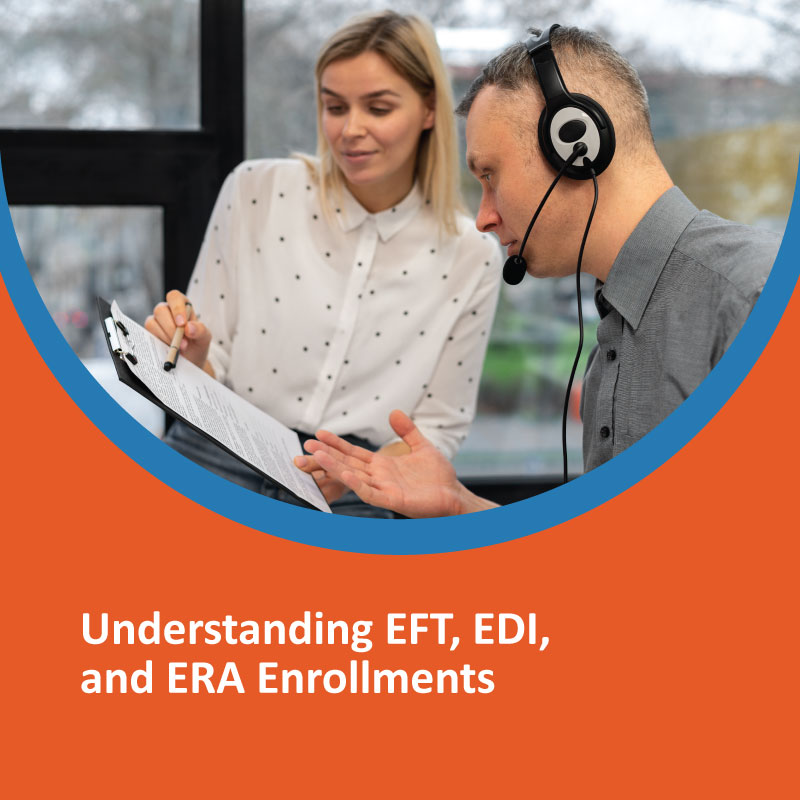Due to the latest technology and advancements, electronic transactions are becoming popular daily. Electronic transactions are also used in medical billing for efficient payment processes and claims management. The billing processes include three systems: EFT (Electronic Funds Transfer), EDI (Electronic Data Interchange), and ERA (Electronic Remittance Advice). Such electronic transactions minimize paperwork and improve cash flow. Healthcare providers can get paid quicker after enrolling in these systems since they electronically submit their claims and take control of their billing processes.
These processes provide more security and efficiency with digital payment. Through EFT, funds can be deposited straight into the providers’ accounts. EDI aids in the electronic filing of claims, among other transactions, and ERA provides electronic remittances that replace the formerly established EOB. Knowing these enrollments is essential for healthcare providers who want to enhance their revenue processes.
1. Electronic Funds Transfer (EFT) Enrollment
EFT is an electronic transfer method that facilitates payments and enables health service providers to receive direct payments from payers. Almost all insurers, such as Medicare and Medicaid, utilize EFT enrollment for quicker and safer payments.
Benefits of EFT Enrollment
Faster payments: Reduces delays compared to paper checks.
Enhanced security: Lowers the risk of fraud and lost checks.
Reduced administrative burden: It reduces the administrative burden.
Improved cash flow enables predictable and timely reimbursements, resulting in better cash flow.
EFT Enrollment Process
Obtain an EFT Enrollment Form through the payer’s website or provider portal.
First, for the EFT enrollment process, provide the patient’s banking information, such as bank name and account number.
Attach Supporting Documents: Any voided check or bank letter is required for more verification.
Submit the Application: Payers allow submission via online portals, email, or fax.
Verification & Testing: The payer may conduct a test deposit before final approval.
Receive Confirmation: All future payments will be processed via EFT once approved.
With the increased digital payment systems, some payers offer immediate fund transfers, reducing payment processing times from days to hours.
2. Electronic Data Interchange (EDI) Enrollment
The enrollment of Electronic Data Interchange (EDI) in medical billing is the integration of EDI software into the systems of a healthcare provider. Healthcare providers can share EDI Patient information with insurance companies and other payers.
Benefits of EDI Enrollment
Increased efficiency: Reduces paperwork and administrative workload.
Faster claims processing: It provides speedier claim processing that reduces claim denials. Accelerates reimbursements and reduces denials.
Improved accuracy: When there are low errors in data entry, accuracy improves.
Secure data exchange: Compliance with HIPAA and other industry standards.
EDI Enrollment Process
Identify the Payer’s EDI Requirements: Each payer has specific EDI submission guidelines.
Choose a Clearinghouse (if needed): Some providers use third-party clearinghouses to manage transactions.
Complete the EDI Enrollment Form. It requires provider details, NPI, and tax ID.
Obtain a Trading Partner ID: Issued by the payer to authenticate EDI transactions.
Perform Test Transactions: Ensures successful data transmission before going live.
Receive Approval & Start Using EDI: Providers can begin submitting claims electronically once verified.
EDI systems have improved crucially with AI software. It reduces claim rejections and real-time eligibility verification, enhancing billing accuracy.
3. Electronic Remittance Advice (ERA) Enrollment
ERA is the digital version of an Explanation of Benefits (EOB) detailing claim payment information, adjustments, and denials. Enrolling in ERA allows providers to automate payment posting and reconcile accounts with minimal manual intervention.
Benefits of ERA Enrollment
Faster claim reconciliation: Eliminates manual data entry for payments.
Reduced paperwork; Providers no longer need to handle paper-based EOBs.
Improved payment accuracy: Identifies underpayments and denials instantly.
Seamless integration with billing systems: Automates remittance posting in electronic health records (EHRs).
ERA Enrollment Process
Obtain an ERA Enrollment Form, which is available from the payer’s provider portal or clearinghouse.
Provide Provider & Billing Details – Includes NPI, Tax ID, and banking information.
Specify ERA Delivery Method: Choose whether ERAs will be sent directly or through a clearinghouse.
Submit the Enrollment Form: Payers accept submissions via web portal, email, or fax.
Verification & Testing: The payer confirms correct data formatting and transmission.
Start Receiving ERAs: Once approved, ERAs replace paper remittance statements.
New security measures now encrypt ERA data to prevent fraud, and many payers offer real-time ERA notifications to speed up claims reconciliation.
Conclusion
EFT, EDI, and ERA enrollments are essential for healthcare providers looking to optimize billing and payment processes. EFT ensures faster and more secure payments, EDI streamlines claims processing, and ERA simplifies remittance reconciliation. Providers can improve efficiency, reduce errors, and enhance cash flow management by adopting these electronic systems. Electronic transactions are becoming more reliable and efficient with continuous advancements in automation and security.
Frequently Asked Questions (FAQs)
Q1. How long does completing EFT, EDI, and ERA enrollment take?
EFT enrollment typically takes 7–30 days, while EDI and ERA enrollments can take 10–45 days, depending on the payer. Some payers may require test transactions before activation.
Q2. Can I enroll in EDI without a clearinghouse?
Yes, some payers allow direct EDI enrollment. However, using a clearinghouse simplifies multi-payer management and reduces setup complexities.
Q3. What should I do if an EFT or ERA payment is missing?
Check your payer portal or clearinghouse dashboard for transaction details. If they are missing, contact the payer’s EDI support team and verify your enrollment status.
Q4. Is ERA enrollment required for EFT payments?
(No, but many payers recommend enrolling in EFT and ERA to fully automate the payment and remittance process, reducing manual reconciliation efforts.


